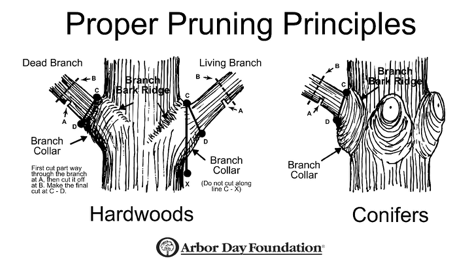February 17, 2018
Pruning Dos and Don’ts
Question:
I get stressed this time of year because I know it is time to prune our landscape trees. Can you give some tips on how to prune with confidence?
- Geri T., Albuquerque
Answer:
The task of pruning used to stress me out too. Every winter I’d watch a few YouTube videos, take some deep breaths, and then put pruning off for another time because I felt that my skills weren’t good enough to—cut it.
It is actually good that you are reluctant to jump outside and whack away without an action plan. While some pruning may be necessary for safety and canopy manipulation, any time we cut into a tree we are creating a potential site for infection. One form of chronic tree torture is pruning annually just because.
Tree wounds never heal. They can seal, but only if cut properly. At the base of each stem, where it meets the trunk, there is a special area called the branch collar (Fig. 1). Think of the trunk as wearing a short-sleeved shirt with the sleeve bunched up (branch collar) and the branch as the arm extending out of the sleeve. The tissue in the branch collar (bunched sleeve) is capable of sealing a clean-cut pruning wound, but only if the entire branch collar is in place. This means that there will be a bump on the trunk after pruning, but at least it will seal. If a flush cut is made, there will not be enough collar to seal the wound. Often, the branch collar is observable, but even if you can’t see it, you should try to visualize it so that you are sure to leave the branch collar tissues intact. Don’t nick the collar.

The bigger the wound, the harder the tree has to work and the longer it will take to seal it. This is why the best approach is to prune at the time of planting, when the branches and pruning wounds are the smallest. Ideally, you will never have to prune it again. Here are some guidelines for selecting branches to prune at any stage of tree growth:
The ABCDs of pruning (starting with D)
-
D is for Dead. Dead branches go first. It can be difficult to identify a dead branch in the winter though, but luckily it's always a good time to prune a dead branch, so when you see one, go ahead and prune it out, regardless of the season.
-
A is for Apical. Apical dominance pruning involves selecting and promoting a central leader, which is the main stem from the trunk up through the canopy to the top of the tree. Apical just means apex or tip. Most trees are pruned for apical dominance and display the classic A-form tree: you can visually follow the main stem from the lowest branch up to the top of the tree in a relatively straight line as it tapers and supports lateral branches. Some fruit trees, like peaches, generate higher yields when sunlight is encouraged to get into the inner canopy using an "open-center" form instead of the A-form. Another example of a tree that didn't read the book about correct form might be a beautiful desert willow that has multiple stems starting from a V-vase shaped trunk.
-
B is for Bad. Prune out the bad branches that are weak and might pose a hazard if they were to fall. Damaged, diseased, or structurally defective branches may be detrimental to the long-term health and structure of the tree. Take the time to determine if serious pests like cankers or galls are the cause of decay, malformations, or cracks. If infectious diseases are present, you'll need to keep tools clean so that you are not spreading problems from plant to plant. If you need help identifying a pest, contact the NMSU Plant Diagnostic Clinic. In the meantime, disinfect pruning tools between cuts.
-
C is for Competing. Competing branches grow in ways that impede the growth of other branches, like rubbing, or cause clearance issues, like for pedestrians. These branches may not be competing yet, but if you foresee that you will have to prune one of them eventually, go ahead and take it out now.
Of course, I can't include all of the pruning rules in this little column. Visit my blog this week for recommended pruning techniques, the best tools, and how to disinfect them Desert Blooms.
Marisa Y. Thompson, PhD, is the Extension Horticulture Specialist, in the Department of Extension Plant Sciences at the New Mexico State University Los Lunas Agricultural Science Center, email: desertblooms@nmsu.edu, office: 505-865-7340, ext. 113.
Links:
For more gardening information, visit the NMSU Extension Horticulture page at Desert Blooms and the NMSU Horticulture Publications page.
Send gardening questions to Southwest Yard and Garden - Attn: Dr. Marisa Thompson at desertblooms@nmsu.edu, or at the Desert Blooms Facebook page.
Please copy your County Extension Agent and indicate your county of residence when you submit your question!